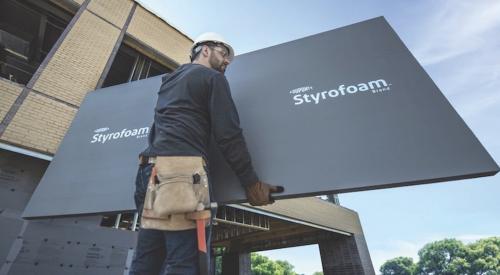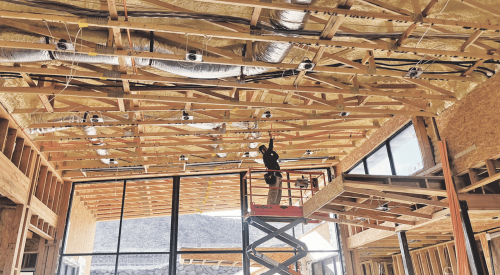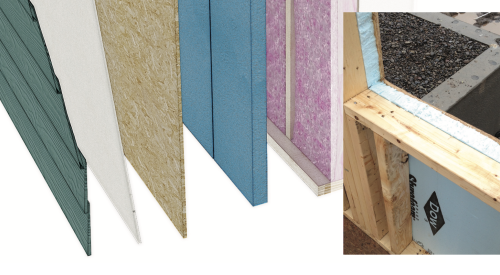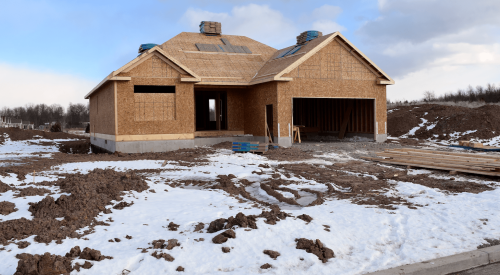Continuous insulation (CI) is a vital component in the construction of wood-framed homes, particularly for builders in states that have adopted the residential energy codes established by the International Energy Conservation Code (IECC). With the pending release of the 2024 IECC, builders are relying on innovations in CI and other building envelope solutions to keep pace and provide code-compliant thermal performance to lower home energy use. Which states are leading the way in IECC adoption and what role does CI play for every state in meeting IECC standards?
To answer these questions, the following offers a state-by-state overview of which IECC codes are in effect and where, expectations for the 2024 IECC, and an update on developments in CI solutions that can help states meet these stricter codes.
IECC Adoption by State
The IECC has progressively enhanced energy efficiency standards for residential construction, with a focus on CI for wood-framed homes. The 2018 IECC introduced stringent residential R-value requirements for CI, and the following 2021 IECC represented a 40% improvement in energy efficiency for residential buildings compared to the 2006 version. In the 2021 IECC, CI R-values range from R5 to R20. For example, Climate Zone 3 has a minimum insulation value of R20 that can be met using a combination of R13 and R5 CI or R15 CI alone. Climate Zone 5 has a minimum insulation value of R30 that can be met using R20 and R5 CI, R13 and R10 CI, or R20 CI alone. Regardless of the climate zone, all residential minimum insulation standards for wood-framed homes include CI as an important component in improving overall energy performance.

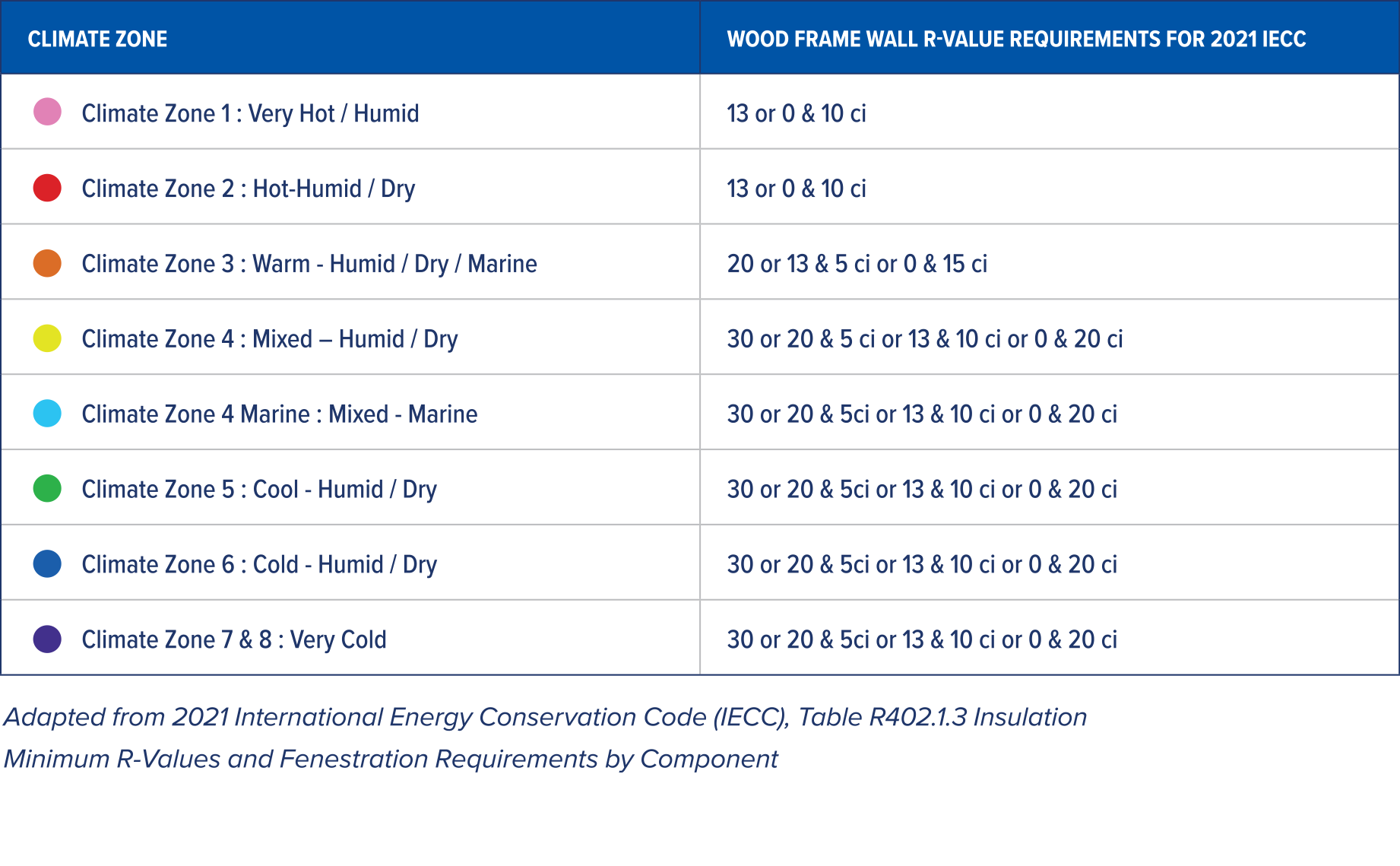
Several states that have adopted variations of either the 2018 or 2021 IECC standards have already shown measurable improvements in energy efficiency.1 These states include:
- 2018 IECC: Oregon, New Mexico, Nebraska, Louisiana, Florida, Virginia, Maryland, Delaware, Pennsylvania, New York, Massachusetts, New Hampshire
- 2021 IECC: Washington, California, Illinois, New Jersey, Connecticut, Vermont, Hawaii
Among the states leading the pack, Washington is one that follows its own state energy code in addition to the 2021 IECC. Washington’s code mandates a significant increase in the use of CI, with specific R-value requirements for various climate zones. For instance, in western Washington, builders must use R21 cavity insulation combined with R5 CI for wood-framed walls. Similarly, California’s Title 24 energy code requires high-performance attics and walls that integrate advanced CI. Likewise, Vermont follows Residential Building Energy Standards tailored to its climate and sustainability goals. These custom approaches have led to substantial reductions in energy use across these states.
Since Washington, California, and Vermont have implemented more rigorous energy codes of their own, they are the most likely early adopters of the forthcoming 2024 IECC. This next release will update residential insulation minimum R-values and corresponding R-values for CI and include stricter air-sealing requirements. These changes reflect the IECC's ongoing commitment to reducing energy consumption and promoting sustainable building practices. As the standards become stricter, CI will play an increasingly critical role in helping states meet and exceed energy efficiency requirements.
Even in states that have not adopted IECC code requirements, such as North Dakota, South Dakota, Wyoming, Colorado, Kansas, Missouri, and Mississippi, adopting energy-efficient practices that include CI can offer significant benefits. By incorporating CI into their building practices, builders in these states can help homeowners enjoy lower energy bills, increased indoor comfort, and a reduced environmental footprint. Additionally, energy-efficient homes have a higher market value and greater appeal to environmentally conscious buyers, providing a competitive edge in the real estate market. This can be a valuable tool in attracting new residents to a state, particularly for areas concerned with population decline.
Building Envelope Advances Continue to Help States Keep Pace
As building codes evolve, ongoing advances in CI for wood-frame construction are helping states stay up to date with the changes. One recent innovation is Blueskin® VPTech™ from Henry®, which integrates multiple building envelope functions into a single lightweight 4’x8’ panel. The panel includes Type II nominal 1” R5 graphite polystyrene (GPS) CI, a self-sealing and drainable weather-resistive barrier (WRB), and pre-applied vertical and horizontal seam-sealing overlays. The integrated design helps builders meet or exceed code requirements for CI and R-values and offers other advantages such as up to 30% faster installation.2 With advances in building envelope systems that combine CI and moisture control, builders across the country can more efficiently and effectively keep up with changes in IECC standards.
CI remains a crucial tool in residential construction, particularly for builders in states adhering to the latest IECC standards. States like Washington and California exemplify the benefits of adopting more stringent energy codes. Even in states without mandatory IECC codes, more efficient CI solutions offer a pathway to lower energy costs and increased home values. Regardless of where your state stands in meeting IECC standards, Blueskin VPTech offers the opportunity to leverage innovation to build homes with better energy performance.
1Source: Status of State Energy Code Adoption: Residential Buildings https://public.tableau.com/app/profile/doebecp/viz/BECPStatusofStateEnergyCodeAdoption/ResidentialDashboard
2During trials with independent building contractors, Blueskin VPTech installed 30% faster than CI and WRB installed as separate components.
CONTACT
800-486-1278
ProductSupport@henry.com
https://www3.henry.com/vptech



